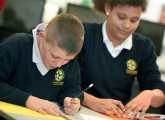As the author Jeanette Winterson wrote: “A tough life needs a tough language - and that is what poetry is”.
When we explore the impact that poetry can have in the classroom, we discover what original and authentic responses it can elicit across the secondary curriculum and how this form of self-expression, seemingly free from rules, can do wonders by stealth in applying key writing skills. We instinctively know that when pupils are engaged and have purpose to write they are more likely to write with passion, read with interest and talk enthusiastically.
If we are concerned about finding deeply motivating routes into reading and writing for pupils then it’s worth noting that the findings from the National Literacy Trust research, Children’s and Young People’s Reading in 2014, showed that reading lyrics has increased year-on-year for young people. While there continues to be a link between socio-economic background and reading enjoyment, pupils on free school meals were found to read more poetry outside school than fiction.
While spoken word nights, poetry slams and artists like Mr Gee, George the Poet and Kate Tempest gain major media currency, the art form is being seen as far from niche for pupils. Be it page poetry, spoken word or performance poetry, there is a growing appetite and opportunity to capitalise on the power of poetry in schools.
Playfulness and power
The National Literacy Trust’s work with schools shows that poetry crosses boundaries that little else can. It allows pupils to put language to use and to find a voice that many have never shown in their written work before but which gives them confidence and freedom.
Poetry is also a powerful force in fostering an inclusive and supportive classroom atmosphere. It encourages pupil critique along with performance and a level playing field where teachers and pupils can share their work alongside each other. Performing work is a terrifying thing, even for seasoned professionals. For teachers who write their own poems and perform work alongside pupils in all its messy glory, it may be a scary prospect – but it is an admirable and necessary risk to take.
Poetry is inherent in all forms of writing – words, ideas and communication are at its heart. So concentration on poetry benefits writing in all other areas of the curriculum. Poetry offers a deeply creative way to connect with language and to engage with literacy on pupils’ own terms. The magic of poetry in the classroom is that it is often the pupils who previously struggled who blossom in writing and sharing their own work. But the right support is essential. Many teachers claim to have little or no poetry experience and question how to begin. How can you mark poetry? Where do you position it in the curriculum to have value? What is a quality poem?
Teaching poetry is less about showing pupils how to be ‘good at’ poetry, and more about encouraging them towards a curiosity about poems and how they work; a willingness to play with language and a desire to discover and define their individual writing style. Poetry can be a way of immersing a class in any curricular topic, introducing rich and new vocabulary whilst assessing the key writing skills of planning, drafting and editing.
Words and music
A new National Literacy Trust initiative is examining how song lyrics can develop a passion for poetry and writing. Using songs in the charts from artists like Rihanna and Katy Perry, students have put lyrics under a lens, looking closely at imagery, rhythm, rhyme, repetition and how these elements create an emotional impact on a listener or reader. This analysis and the resulting discussion enables young people to pen their own lyrics, drawing on new vocabulary and grammatical constructs, all under the guise of writing as lyricists for their own band.
Making an impact
During the last year, the National Literacy Trust has worked with a range of poets in workshops that have supported hundreds of teachers to get under the skin of writing and performing poems of their own. This inspires a new-found confidence in exploring poetry as part of the secondary curriculum.
Teachers have been overwhelmingly positive about how poetry has been an uplifting experience and has a positive impact on attitudes and writing attainment, particularly among lower achieving pupils.
Year 7 pupils from Penwortham Academy in Preston participated in Picture the Poet, a National Literacy Trust partnership project with the National Portrait Gallery and Apples & Snakes. The lead teacher observed a ‘noticeable change’ in pupils’ behaviour and that engagement in subsequent lessons had improved as a result of their newfound confidence. Poetry is universal and their project on poetry self portraits put personal experience at the heart of their writing where, for once, they were the experts – only they could be the authority to write about themselves. As one pupil later stated: “Poetry is within us all”.
ABOUT THE AUTHOR
Erin Barnes is Schools Project Manager, Picture the Poet, at the National Literacy Trust.










